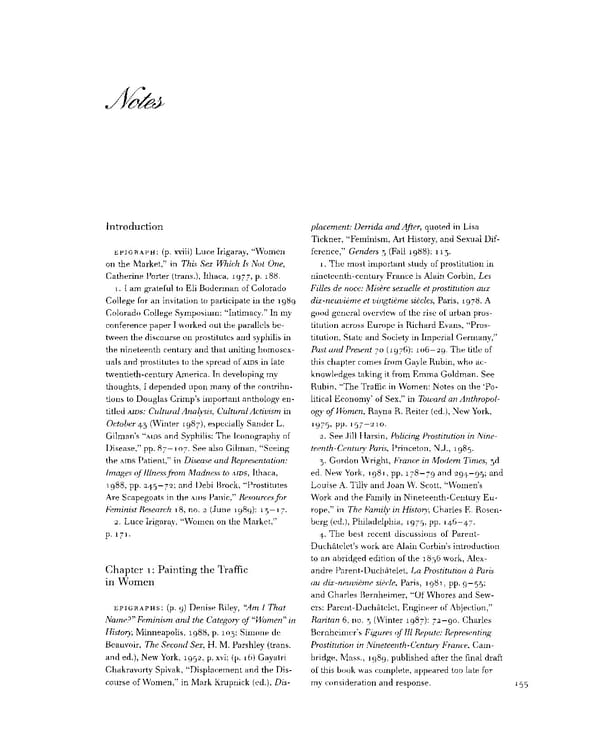Notes Introduction placement: Derrida and After, quoted in Lisa Tickner, "Feminism, Art History, and Sexual Dif- EPIGRAPH: (p. xviii) Luce Irigaray, "Women ference," Genders 3 (Fall 1988): 113. on the Market," in This Sex Which Is Not One, 1. The most important study of prostitution in Catherine Porter (trans.), Ithaca, 1977, p. 188. nineteenth-century France is Alain Corbin, Les 1. I am grateful to Eli Boderman of Colorado Filles de noce: Misere sexuelle et prostitution aux College for an invitation to participate in the 1989 dix-neuvieme et vingtieme siecles, Paris, 1978. A Colorado College Symposium: "Intimacy." In my good general overview of the rise of urban pros- conference paper I worked out the parallels be- titution across Europe is Richard Evans, "Pros- tween the discourse on prostitutes and syphilis in titution, State and Society in Imperial Germany," the nineteenth century and that uniting homosex- Past and Present 70 (1976): 106—29. The title of uals and prostitutes to the spread of AIDS in late this chapter comes from Gayle Rubin, who ac- twentieth-century America. In developing my knowledges taking it from Emma Goldman. See thoughts, I depended upon many of the contribu- Rubin, "The Traffic in Women: Notes on the 'Po- tions to Douglas Crimp's important anthology en- litical Economy' of Sex," in Toward an Anthropol- titled AIDS: Cultural Analysis, Cultural Activism in ogy of Women, Rayna R. Reiter (ed.), New York, October 43 (Winter 1987), especially Sander L. 21 !975> PP- !57- o- Oilman's "AIDS and Syphilis: The Iconography of 2. See Jill Harsin, Policing Prostitution in Nine- Disease," pp. 87—107. See also Gilman, "Seeing teenth-Century Paris, Princeton, N.J., 1985. the AIDS Patient," in Disease and Representation: 3. Gordon Wright, France in Modern Times, 3d Images of Illness from Madness to AIDS, Ithaca, an( ed. New York, 1981, pp. 178 — 79 and 294—95; ^ 1988, pp. 245 — 72; and Debi Brock, "Prostitutes Louise A. Tilly and Joan W. Scott, "Women's Are Scapegoats in the AIDS Panic," Resources for Work and the Family in Nineteenth-Century Eu- Feminist Research 18, no. 2 (June 1989): 13—17. rope," in The Family in History, Charles E. Rosen- 2. Luce Irigaray, "Women on the Market," berg (ed.), Philadelphia, 1975, pp. 146—47. p. 171. 4. The best recent discussions of Parent- Duchatelet's work are Alain Corbin's introduction to an abridged edition of the 1836 work, Alex- Chapter i: Painting the Traffic andre Parent-Duchatelet, La Prostitution a Paris in Women au dix-neuvieme siecle, Paris, 1981, pp. 9 — 55; and Charles Bernheimer, "Of Whores and Sew- EPIGRAPHS: (p. 9) Denise Riley, "Am I That ers: Parent-Duchatelet, Engineer of Abjection," Name?" Feminism and the Category of "Women' in Raritan 6, no. 3 (Winter 1987): 72 — 90. Charles History, Minneapolis, 1988, p. 103; Simone de Bernheimer's Figures of III Repute: Representing Beauvoir, The Second Sex, H. M. Parshley (trans, Prostitution in Nineteenth-Century France, Cam- and ed.), New York, 1952, p. xvi; (p. 16) Gayatri bridge, Mass., 1989, published after the final draft Chakravorty Spivak, "Displacement and the Dis- of this book was complete, appeared too late for course of Women," in Mark Krupnick (ed.), Dis- my consideration and response. !55
 Prostitution & Impressionists Page 175 Page 177
Prostitution & Impressionists Page 175 Page 177